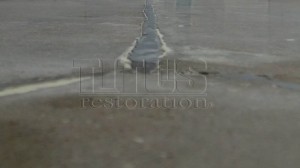
Filled joint lines provide protection from spalls and worn joints.
For many building owners, facilities maintenance, and property managers, there are more things to worry about than the concrete floor joints. But, now many be the time to consider if concrete joint sealer is necessary, before it is too late.
Why Concrete Joint Sealer Can Save you in the Long Run:
1. Protection: Your concrete floor is a huge investment, don’t you want it to last? Installing concrete joint sealer is an important step in protecting the slab. Control joints are cut in the slab when it is poured to control the cracking, if done properly your slab should not have any surface cracks. Once the slab has finished curing, the control joints no longer have a purpose. Control joint filler is a rigid product, it is not flexible. (Flexible joint sealers are used in expansion joints, not control joints). So, this rigid material provides a hard surface for wheeled traffic, like heavy forklifts, to travel over rather than destroy.
2. Cost: To fill the joints initially is the most cost effective way to protect the slab. Installing concrete joint filler a minimum of 90 days after the slab was poured will allow for most shrinkage, a good time for the joints to be filled. You can expect to pay $1-$3 per lineal feet of joints (depending on the size of the building) if the building’s joints are unfilled and in good condition. Waiting until the joints have spalled or cracked will run about $5-$15 per lineal feet of joints depending on how bad they are. For joints that have completely been deteriorated, people have paid as much as $50 per lineal foot for joint repair. Seems like a no-brainer!
3. Environment: The last thing to consider when considering installing concrete joint sealer is the environment. If you are handling chemicals or other toxins and you have a spill in your facility and the joints are not filled; all that toxic waste is going to run through the slab and into the soil and groundwater. The EPA does not take these things lightly. They are typically followed by large fines that could have been avoided if the concrete control joints were filled and sealed up.
What Concrete Joint Sealer is Not Intended to Do:
Because control joint filler is not very flexible, it is not intended for expansion joints or areas where settling and shrinkage is still occurring. When the concrete moves, rigid joint fillers are going to separate from the concrete. Separation that is less than the width of a credit card is not considered a failure, but if you are in a USDA or FDA regulate environment you may require some touch ups. This lack of flexibility is why control joint filler is perfect for protecting the concrete slab from further damage.
Titus Restoration provides quality and industrial concrete joint sealer in concrete slabs across the country. For new or old concrete floors, we can provide you pricing on concrete floor joint selear.
